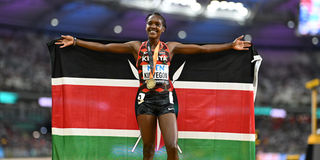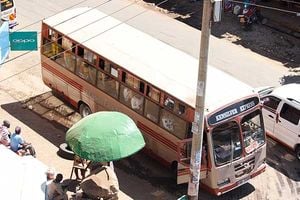We need a national policy to guide on kit worn by Team Kenya

Kenya's Faith Kipyegon poses with her national flag after winning the women's 1500m final during the World Athletics Championships at the National Athletics Centre in Budapest on August 22, 2023.
What you need to know:
- Kenyan sports and kit have been a very emotional national conversation for several years.
- The fact that athletes are our representatives, we want to see them looking the part as it reflects on the nation.
When a Kenyan team enters an international sports event, we have certain expectations of the way they will look.
The first expectation is to see a representation of the colours of our flag in their kit.
The next thing noticeable in any national kit is the design, the manufacturer, and the branding.
Kenyan sports and kit have been a very emotional national conversation for several years.
The fact that athletes are our representatives, we want to see them looking the part as it reflects on the nation.
At one point the conversation was around stolen athletes kit being sold to the public.
This moved on to athletes not getting kit while on international assignments. Recently it was athletes did not get enough kit or they didn’t have appropriate kit for competition. We have moved pretty fast and now the conversation is on the brand of kit while at one point it was the design of the kit. We eagerly wait for this to move even further to a more ambitious level of commercialization of the Kenyan kit.
This draws us to the conversation of what goes into a national kit.
The first consideration is the national colours, customarily the colours of the flag. The other consideration is partnership with a manufacturer, often negotiated by the National Olympic Committee or National Sports Council, national federations or clubs.
The common denominator in all these should be the colour schemes, correct use of the pantones and their application in apparel. This particular aspect is best understood by looking at Australia, Jamaica, Nigeria, South Africa and Cameroon to just mention a few. They all have a distinctly recognizable predominant green identifiable and associated with each country.
For the Tokyo 2020 Olympics, through NOC-K partnership Nike provided the official kit, the Ministry provided the ceremonial uniforms and sponsors provided travel kit.
The designs change between the seasons. All quadrennial event kits have never been the same.
Appropriate sports kit from manufacturers are costly because of the advancement of technology behind each sport item. What is considered as just a swimming costume for an elite swimmer can cost over Sh75,000.
Design of the travel kit for Tokyo Olympics was through a public competition in which the winning designs were moderated by the Kenya Fashion Council.
Nike has partnership with both NOC-K and Athletics Kenya. With NOC-K, the apparel company provides for very specific events pretty much like every other sponsorship contract. These include Summer Olympics, Commonwealth Games and African Games. These are commercial free events, with apparel having only the manufacturers logo and the national flag.
In the last few years NOC-K’s programs have expanded to include Youth Games and Beach Games. Over and above NOC-K providing for these specific events, we have sometimes complemented government in supporting National Federations in their multiple international engagements by providing basic kit.
Over 90 per cent of our federations do not have kit contracts. A national policy on all national teams’ kit would give us a common theme with respective application of international federation rules for each sport and championship.
Mutuku is the Secretary General of the National Olympic Committee of Kenya. [email protected]




